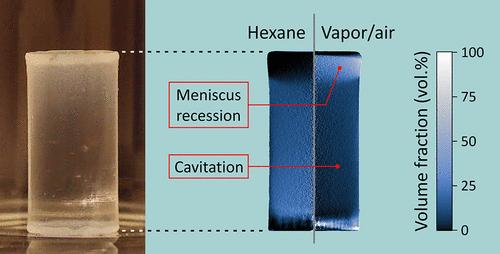Our official English website, www.x-mol.net, welcomes your
feedback! (Note: you will need to create a separate account there.)
Solvent Cavitation during Ambient Pressure Drying of Silica Aerogels
Langmuir ( IF 3.7 ) Pub Date : 2024-06-12 , DOI: 10.1021/acs.langmuir.4c00497 Julien Gonthier 1 , Ernesto Scoppola 1 , Tilman Rilling 1 , Aleksander Gurlo 2 , Peter Fratzl 1 , Wolfgang Wagermaier 1
Langmuir ( IF 3.7 ) Pub Date : 2024-06-12 , DOI: 10.1021/acs.langmuir.4c00497 Julien Gonthier 1 , Ernesto Scoppola 1 , Tilman Rilling 1 , Aleksander Gurlo 2 , Peter Fratzl 1 , Wolfgang Wagermaier 1
Affiliation

|
Ambient-pressure drying of silica gels stands out as an economical and accessible process for producing monolithic silica aerogels. Gels experience significant deformations during drying due to the capillary pressure generated at the liquid–vapor interface in submicron pores. Proper control of the gel properties and the drying rate is essential to enable reversible drying shrinkage without mechanical failure. Recent in operando microcomputed X-ray tomography (μCT) imaging revealed the kinetics of the phase composition during drying and spring-back. However, to fully explain the underlying mechanisms, spatial resolution is required. Here we show evidence of evaporation by hexane cavitation during the ambient-pressure drying of silylated silica gels by spatially resolved quantitative analysis of μCT data supported by wide-angle X-ray scattering measurements. Cavitation consists of the rupture of the pore liquid put under tension by capillary pressure, creating vapor bubbles within the gels. We found the presence of a homogeneously distributed vapor-air phase in the gels well ahead of the maximum shrinkage. The onset of this vapor/air phase corresponded to a pore volume shrinkage of ca. 50 vol % that was attributed to a critical stiffening of the silica skeleton enabling cavitation. Our results provide new aspects of the relation between the shape changes of silica gels during drying and the evaporation mechanisms. We conclude that stress release by cavitation may be at the origin of the resistance of the silica skeleton to drying stresses. This opens the path toward producing larger monolithic silica aerogels by fine-tuning the drying conditions to exploit cavitation.
中文翻译:

二氧化硅气凝胶常压干燥过程中的溶剂空化
硅胶的常压干燥是生产整体二氧化硅气凝胶的一种经济且可行的方法。由于亚微米孔隙中液-气界面处产生的毛细管压力,凝胶在干燥过程中经历显着变形。正确控制凝胶特性和干燥速率对于实现可逆干燥收缩而不产生机械故障至关重要。最近的操作微计算机 X 射线断层扫描 (μCT) 成像揭示了干燥和回弹过程中相组成的动力学。然而,为了充分解释潜在的机制,需要空间分辨率。在这里,我们通过广角 X 射线散射测量支持的 μCT 数据的空间分辨定量分析,展示了硅烷化硅胶常压干燥过程中己烷空化蒸发的证据。空化是指毛细管压力作用下的孔隙液体破裂,在凝胶内产生蒸汽泡。我们发现在最大收缩之前,凝胶中存在均匀分布的蒸气-空气相。该蒸气/空气相的开始对应于约约的孔体积收缩。 50 vol%,归因于二氧化硅骨架的临界硬化,从而实现空化。我们的结果为干燥过程中硅胶形状变化与蒸发机制之间的关系提供了新的方面。我们得出的结论是,空化引起的应力释放可能是二氧化硅骨架抵抗干燥应力的根源。这为通过微调干燥条件以利用空化来生产更大的整体二氧化硅气凝胶开辟了道路。
更新日期:2024-06-12
中文翻译:

二氧化硅气凝胶常压干燥过程中的溶剂空化
硅胶的常压干燥是生产整体二氧化硅气凝胶的一种经济且可行的方法。由于亚微米孔隙中液-气界面处产生的毛细管压力,凝胶在干燥过程中经历显着变形。正确控制凝胶特性和干燥速率对于实现可逆干燥收缩而不产生机械故障至关重要。最近的操作微计算机 X 射线断层扫描 (μCT) 成像揭示了干燥和回弹过程中相组成的动力学。然而,为了充分解释潜在的机制,需要空间分辨率。在这里,我们通过广角 X 射线散射测量支持的 μCT 数据的空间分辨定量分析,展示了硅烷化硅胶常压干燥过程中己烷空化蒸发的证据。空化是指毛细管压力作用下的孔隙液体破裂,在凝胶内产生蒸汽泡。我们发现在最大收缩之前,凝胶中存在均匀分布的蒸气-空气相。该蒸气/空气相的开始对应于约约的孔体积收缩。 50 vol%,归因于二氧化硅骨架的临界硬化,从而实现空化。我们的结果为干燥过程中硅胶形状变化与蒸发机制之间的关系提供了新的方面。我们得出的结论是,空化引起的应力释放可能是二氧化硅骨架抵抗干燥应力的根源。这为通过微调干燥条件以利用空化来生产更大的整体二氧化硅气凝胶开辟了道路。





















































 京公网安备 11010802027423号
京公网安备 11010802027423号